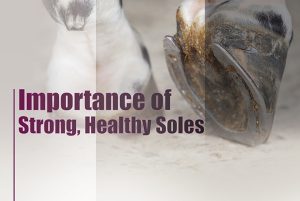Importance of Strong, Healthy Soles
Click here to read the complete article
190 – March/April, 2020
Your horse stepped on a rock and has been gimpy for several days. Your farrier examined the foot and said it looks like a mild stone bruise and mentioned that your horse has thin soles. Is there some way to help the horse develop a thicker, stronger sole?
WHAT MAKES A GOOD SOLE?
A healthy hoof has a strong, healthy sole, but sole depth varies a lot from horse to horse, according to Paul Goodness, Chief of Farrier Services at Virginia Tech’s Equine Medical Center in Leesburg, Virginia. “A healthy sole is important because it supports and protects the sensitive inner structures of the foot. When the sole is healthy it has good shock absorbing characteristics as well,” he says. Thus, it affects the health and soundness of the leg above it.
A healthy sole is normally arched from front to back and side to side, rather than flat. The bottom of the foot has a nice cup. This gives some flexibility and elasticity that can help dissipate concussion when the foot hits the ground. “During maximum weight-bearing, the sole tends to flatten and redirect the vertical load forces into lateral forces, which helps with shock absorption,” Goodness explains.
Dr. Mike Pownall, a farrier veterinarian in Campbellville, Ontario, Canada (McKee-Pownall Equine Services), says a healthy sole grows continually and is part of a healthy foot. “It’s similar to healthy hair in humans. People who grow hair well and fast are usually pretty healthy. When there is good blood flow to the foot, a well-balanced foot, good nutrition, and a good amount of exercise this leads to a healthy sole,” says Dr. Pownall, “As a farrier and a veterinarian, I like to see a sole that has a little bit of give when you put some pressure on it (the sole should be a flexible shock-absorbing structure), but this will depend on how dry and hard the foot is. You might not get a good sense of how much sole there is or how thick it is if the foot is hard.”
“The conformation and shape of the sole is dictated by the conformation and shape of P III (third phalanx, or coffin bone) above it and the lateral cartilages,” says Goodness. The coffin bone of a draft horse has a different shape than that of a typical Arabian, Morgan, or Quarter Horse, for instance. The draft horse’s sole is usually very flat and broad in comparison to the cupped, upright sole of the lighter horses. There are genetic factors that effect the shape of the coffin bone, and the sole mimics that shape.”











